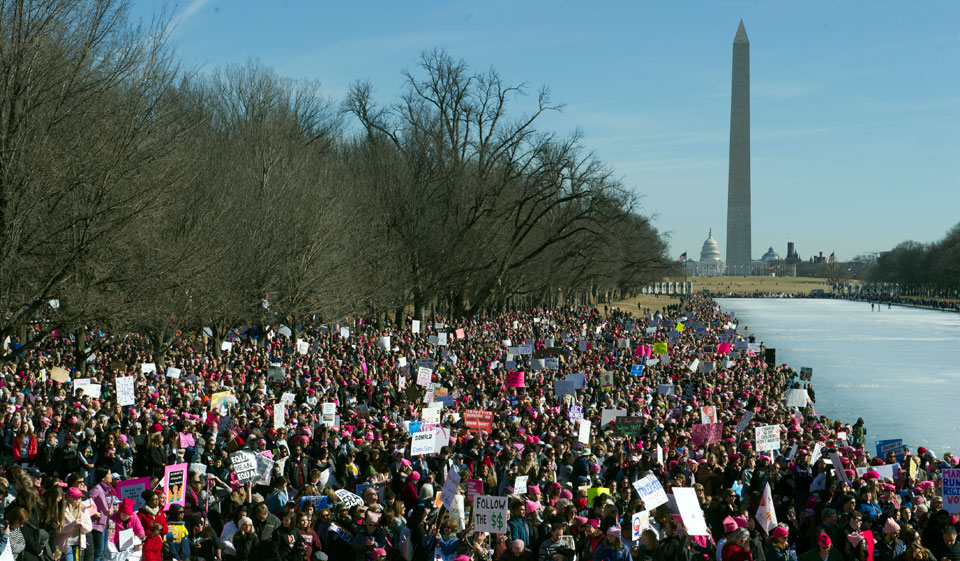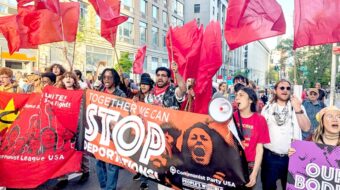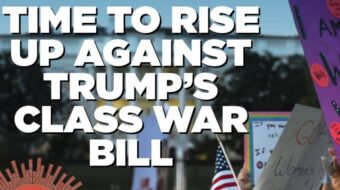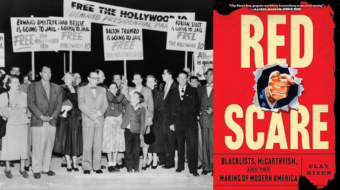
This is part 6 of the full main report, “Unity to save people and planet; For full equality, democracy, peace, and green socialism,” to the 31st National Convention of the Communist Party USA held in Chicago, Illinois, June 21-23, 2019. Other installments available here.
The abbreviated oral presentation is available here.
John Bachtell served as CPUSA national chair from 2014 to 2019. Rossana Cambron and Joe Sims were elected as the new CPUSA co-chairs.
The mass democratic and social movements have grown over the past ten years and are now a significant factor in U.S. politics. These movements, including an openly socialist current, have mobilized and educated the grassroots and helped shift public opinion, in some cases dramatically.
The #MeToo movement helped transform the national conversation on institutionalized sexism and sexual and domestic abuse.
The Black Lives Matters movement helped transform the national conversation on institutionalized racism and white supremacy, criminal justice reform, and police brutality and murder.

The Dreamers and immigrant rights movement helped transform the national conversation on immigration, bringing the undocumented out of the shadows and demanding a path to citizenship.
Transformative campaigns to win a $15 minimum wage helped shift public opinion and won victories in states and municipalities across the country.
Teachers walkouts and strikes transformed the national conversation from demonizing teachers to raising wages and challenging right-wing austerity policies.
Government workers, TSA agents, and airline flight attendants put an end to the 35-day Trump government shutdown when they threatened to shut down the air traffic system nationwide.
Taxing the rich is now taking hold on the state and municipal levels.
The Sunrise and climate justice movements helped transform the national conversation on the climate crisis with the Green New Deal.
Students, parents, and victims of gun violence and their families have helped shift public opinion on gun control and put the NRA is on the defensive.
The Medicare for All movement has helped transform the national conversation on healthcare, which is now seen as a universal right.
The democratic upsurge exploded with the election of Trump. In particular, it was the socially transformative mass movements against sexism and misogyny led by women which intersected with movements against racism and for worker’s rights and other movements.
These movements converged in the 2018 elections, which recorded the highest voter turnout in a midterm election in 50 years as well as the most racially diverse turnout ever. Latino voter turnout doubled, and youth turnout increased by 16%.
A record number of activists, women, people of color, trade unionists, LGBTQ activists, socialists, and now communists, were elected. These newly elected officials are helping transform public opinion and legislative bodies.
Class unity and “identity politics”—no worker left behind
The ruling class understands that the growing unity of organized labor, the nationally and racially oppressed, and women create a powerful foe, capable of radically transforming society.
People of color and women are also fighters, organizers, and unifiers; they bridge the main sectors of the people’s movement.
Trump and the extreme right are aiming their sites directly at this growing unity. They are using anti-immigrant hysteria, Islamophobia, racism, sexism, anti-communism, anti-Semitism, anti-socialism, massive lies, and disinformation in a desperate attempt to drive a wedge in our multi-racial working class and people.
The criminalization of reproductive rights and voting rights and outlawing collective bargaining go hand in hand.
Abortion has been effectively outlawed in 89% of counties. These are many of the same places that have passed voter suppression laws and adopted “surgically gerrymandered” maps and the same states that have passed right to work laws.
Trump and his allies are cynically betting that they can win enough white working-class and male voters and suppress enough people of color, particularly African-American and Latinx voters, and young voters to win key battleground states.
A debate has roiled progressive and democratic movements over the best way to win in 2020. Some say to defeat Trump the democratic movements must focus on economic issues to reach white workers who they view as the key constituency to be won over.
Others argue white male workers are a declining share of the electorate and Democrats should focus on so-called identity politics by focusing on people of color (who will soon constitute the majority and are the most loyal Democratic constituencies), women, LGBTQ voters, and millennials.
It is true that people of color, particularly the African-American and Latinx working-class communities, and women of color, are the most consistent voters and activists for Democratic candidates. African-American women are a decisive voter block and were critical to electing Doug Jones in Alabama.
It is also true that to advance the working class and people as a whole, our entire multi-racial working class and people must be united and mobilized as one.
Therefore, identity politics shouldn’t be countered to working-class issues. These are not mutually exclusive. Instead, the interests of our multi-racial working class and core allies in people of color communities, women, and youth, are inseparable. The interconnection and interrelationship between class, race, and gender must be stressed.
When one speaks of ignoring identity politics, this is code for ignoring special oppression and the solutions necessary to achieve full equality. As Stacey Abrams so eloquently said, “Identity politics is America.”
And yet, jobs and living wages, universal health care, free education, criminal justice reform, and reproductive rights are issues that impact communities of color and women and can unite the entire working class and people.
This was the experience of Abrams’ campaign for governor in Georgia. Abrams made an appeal to the particular issues facing African-American, Latino, and Asian voters, but she also spoke to the urgent problems confronting all voters and campaigned in white working-class communities. By talking to every voter on the issues, turnout overall increased, including white voter turnout for Democrats.
Youth fighting gun violence—including mass shootings at high schools, on campuses, and in communities—had a similar experience. Students at Marjory Stoneman High school in Parkland, Fla., united with African-American youth from Chicago to build a multi-racial movement for gun control, including a national march on Washington, D.C.
In a fight against great odds, “cowboys” and “Indians” (ranchers and Native Americans) united to block the Keystone XL pipeline.

The U.S. working class and people have always been multi-racial, multi-cultural, and multi-lingual, including long before European settlers arrived. We are becoming more so. But the legacies of slavery, the genocide against Native Americans, and the theft of lands from Mexico course through every aspect of society. Inequality and special oppression based on race, nationality, gender, and sexual orientation and identity are interwoven in the capitalist system and have existed throughout U.S. history.
The fight for the unity of our multi-racial, multi-national, multi-gender, multi-generational U.S. working class and advancing equality has also been a common thread in our history. When issues of class, race, and gender are brought together, our working class and people have made their most significant advances. This includes during the Civil War and Reconstruction; the 1930s fights for workers’ rights; the 1960s Civil Rights and women’s equality movements and fight for the Great Society, and the 2008 election of President Barack Obama.
The working class can only play its historical role in bringing about a classless society if it is united. And to achieve unity, the ideologies and practices of racism and sexism must be acknowledged, fought, and addressed with special measures that overcome historic inequality, with the dismantlement of institutionalized racism and sexism.
Elevating the fight for equality; against racism and sexism
Our working class and its unity are under unprecedented and daily ideological assault by the extreme right and its corporate backers.
Racism causes working-class whites to ally with capitalists over their fellow workers of color. Xenophobia causes workers to ally with capitalists over their working-class brothers and sisters from other countries, and misogyny causes working-class men to ally with capitalists over working-class women.
A section of the U.S. working-class, consisting primarily of white workers, have been influenced by right-wing ideology. Forty percent of trade union families voted for Trump in 2016, voting against their own self-interests.
Our working class can never concede one section of workers to the extreme right and its corporate backers who are influenced by racism, sexism, xenophobia, anti-Semitism, or Islamophobia because it is immoral and divides and weakens the entire working class.
Organized labor is the most significant organization bringing together our diverse working class. Unions are often the leading mobilizer, unifier, and political educator.
In many areas, de-industrialization severely weakened industrial unions and their influence on members and their ties to social movements and community allies in key Midwest states. The Democratic Party, under the sway of its Wall Street wing, essentially abandoned many congressional districts and states.
The vacuum was too often filled by the right wing—including Fox News, the NRA, Tea Party, and right-wing Christian Evangelicalism—which then took over state governments and carried out a large-scale attack on fundamental rights.
The only way to counter this is to rebuild a mass organized labor movement allied with the African-American, Latinx, and other communities of color and democratic and social movements. The battle of ideas must be re-engaged.
Rebuilding organized labor and its multi-racial unity—and the unity of industrial unions, service unions, and the building trades—is a strategic imperative to advance a working-class and democratic agenda. And in fact, this is what is happening.
Teachers in “red” states, including many who voted for Trump, have shown how grassroots movements for better wages, working conditions, and education funding can unite diverse constituencies and affect state politics and elect teachers to office. These movements are challenging right-wing policies of underfunding education, regressive taxation, and attacks on public workers.
In many instances, these coalitions are also taking over the Democratic Party apparatus at the local level. These kinds of movements can and must be built in 3,000 counties, across all 50 states.
Our multi-racial working class and democratic movements must win a decisive majority among white workers, therefore advancing the fight against racism is essential. Anti-racist white workers have a special responsibility to engage other white workers.
The same is true for advancing the fight against sexism. Winning a decisive majority among working-class men is essential. Anti-sexist men have a special responsibility to engage other men.
This means engaging white workers who voted for Trump. But it’s also about activating large numbers of white voters who are anti-racist but don’t vote because they have lost confidence in the political system.
People are complicated and have many minds on many issues. A section of people are unmovable racists and misogynists, but a more significant share can be influenced by movements and events.

One example was the so-called “Obama-Trump” voters. Many voted for Democratic candidates in 2018 after experiencing two years of Trump and GOP misrule.
The fight against racism and sexism and for full equality go hand-in-hand. An essential element of class consciousness is the recognition of special oppression and the need to fight ruling class ideas and practices of racism, sexism, all forms of prejudice, and national chauvinism.
An injury to one is an injury to all. The working class and people either stand together, fight together, and rise together for a shared future—or they perish divided.
As Rev. Martin Luther King, Jr. once said the US working class and people were “caught in an inescapable network of mutuality, tied in a single garment of destiny.”
Continued in part 7: Changing world balance of forces and a new stage of globalization










